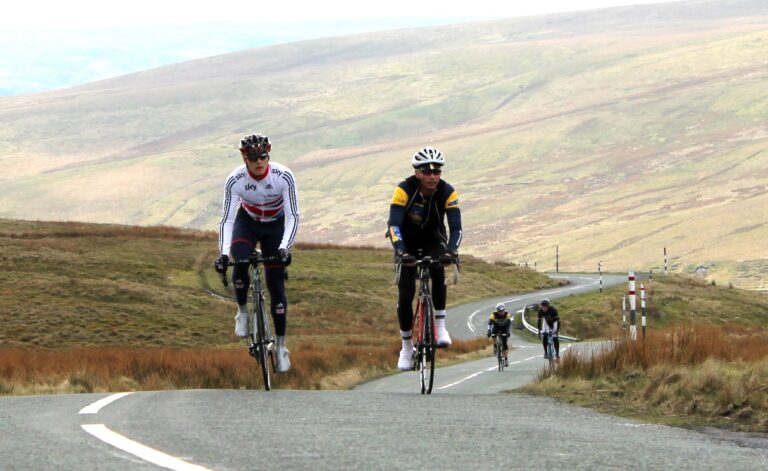Nothing can replicate the buzz of tyres on tarmac and the wind in your hair, but Athlete Lab claims to have brought the open road indoors.
Athlete Lab calls itself a revolution in indoor cycling training and has just opened its first facility on Cannon Street in London having launched in Sydney and Singapore. What is it? Athlete Lab is an indoor cycling studio which uses ‘real’ bikes, rather than spin bikes, to mimic the feel of riding on the road in order to allow City-based cyclists to maximise their midweek training time.

Question is, with British Cycling head coach Shane Sutton signed up as a partner to lead Athlete Lab’s team of coaches, can it take your cycling to the next level? We went along to find out.
You instantly notice the difference between the Athlete Lab’s ‘adjustabikes’ and those in any other indoor training facility. Spin bikes tend to encourage a wider stance, placing the rider in quite a different position to that of a road bike. Instead the adjustabikes make use of a regular bottom bracket and cranks and, in replicating the position used on a normal road bike, encourage you to use your hip flexors – the same muscles you would outside of the lab – instead of your hamstrings, as is the case with standard spin bikes. Athlete Lab say the flywheel of a spin bike makes your hamstrings work harder to slow the pedals as they come around, while on a road bike you use your hip flexors and quadriceps more to pedal against the friction of road and wind resistance.
In fact, it’s not the just the bottom bracket and cranks, but the whole bike is designed to mirror a standard road bike frame and almost every component can be adjusted. The saddle and handlebar can be moved (both vertically and horizontally) to replicate your position on a road bike, and Athlete Lab can setup the adjustabike to your exact measurement if you’ve had a professional bike fit. In effect, the the bike fit within the lab is completely transferable to your road bike and vice versa.
For riders without an exact position, Athlete Lab used two methods of on-the-spot bike fitting while we were there: the first used hip and hand measurements to find a suitable saddle and handlebar position, while the second assessed leg position and reach once on the bike. The reach didn’t just rely on the movement of the saddle and stem back and forth, but the saddle was instead moved horizontally from the bottom of the seatpost, so in effect extending or reducing the length of the toptube and so offering a more precise fit.
That said, being able to adjust everything at once does have its complications, as while you’d normally adjust and replace one component at a time with a regular road bike, such an immediate and overall change can feel quite strange. I went with it, settled in quickly and had no complaints.
Once setup, we were on and spinning – then came the hard bit! Unlike most indoor training facilities, the Athlete Lab doesn’t rely on a rider’s cadence or heart rate. Those numbers are measured and readily available but the focus is on power, which is a more accurate metric to measure effort. Specific tests are run in the testing room of the Athlete Lab to gain precise figures for each individual and thus calculate their Functional Threshold Power. This takes approximately 20 minutes, however, given the short time frame available during the launch of Athlete Lab, our output was gauged on sex, age, weight, and fitness level.

Once completed, the results of the FTP test are used to provide a suggested output value, also known as the hold value, for the training session. The main screen in front of the bike is divided into sections, each providing the rider with their individual data. The task in hand is to maintain your output (watts) at the same value as the hold number provided. Easier said than done! Placed smack bang in the middle of approximately 20 riders, it was just me and my watts and, completely focused on that number alone, nothing else existed. I’m told, however, that with time the ability to focus on your number becomes second nature and then the competition no longer lies between you and the screen but instead between you and your co-riders.
Conveniently located within the City, Athlete Lab claim that one hour in the studio is the equivalent of two on the road and having done a half-an-hour session myself, I would have to agree. The riding is so focused that your attention is diverted from the burning sensation in your legs and held only on the number ahead of you. The data is displayed in graphic form by a power bar that runs from red through amber to green to indicate how close you are to the hold number and the whole process can become extremely addictive in a very short space of time and leave you hungry for more no matter how puffed out you are physically.
While Athlete Lab is able to replicate the feel of a regular road bike, it can also simulate a variety of iconic courses traditionally followed by the pros, like Mont Ventoux, Alpe d’Huez and other roads of the Tour de France. Of course, it’s not the same as being there – and without any cooling breeze any suggestion of a door being opened to let in a little breeze is yearned for – but it eliminates the monotony of indoor training. Individual routes can also be uploaded from your Garmin (or similar devices).
In truth, there’s so much to Athlete Lab that I struggle to simply liken it to road cycling alone but instead consider it almost a discipline in its own right, that in the process of being mastered every other cycling discipline benefits. Aspects such as simulated hill climbs, sprint sections and interval training reflect the reality of road cycling, while having to hold the suggested output felt far more like maintaining the distance between you and the wheel in front in the bunch.
It’s not perfect, of course – the adjustabikes are still missing the feel of cornering, for example, or the movement of the bike – and nothing will replicate the feeling of the open road, but for a static bike, this is a close as I’ve come and a sure-fire way to boost the fitness of time-crunched cyclists.
Website: Athlete Lab





